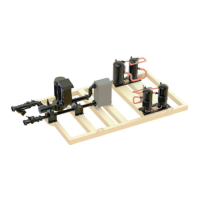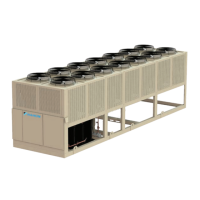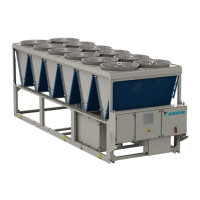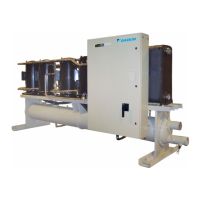www.DaikinApplied.com 43 IOM 1207-6 • TRAILBLAZER
®
MODEL AGZ CHILLERS
Pump Operating Control
Constant Flow
The pumps will run at constant speed and will start and stop
automatically with the chiller unit. When the chiller is enabled to
run by having its MicroTech
®
III unit controller in the Auto state
or by a signal from a BAS (not necessarily with compressors
running based on availability of a cooling load), the pump
panel will receive a signal to start from the chiller controller
when either the chilled water leaving or entering temperature
reaches the chiller freeze point setting to help prevent freeze
up. When there is sucient ow to close the ow switch within
a timed period (recirc timer), a proof-of-ow signal is sent to
the chiller and the pump is in the Run state. If there is a call for
cooling based on the chilled water temperature, the chiller will
commence its compressor startup procedure. If there is no call
for cooling, the chiller will be on stand-by waiting for load.
If the ow switch does not see ow, the pump remains in the
Start state until ow is established, at which time the pump will
be in the Run state. Flow is recognized when the ow switch
indicates ow for longer than the recirc timer setpoint.
The Run state is a control condition established by satisfying
certain conditions. The Start state means that a digital signal
has been sent to the pump for it to start running.
When starting the chiller, it is prudent to be sure there is ow
so the chiller compressors will be able to start based on a call
for cooling due to high chilled water temperature. Observing
water pressure gauges can conrm ow.
Flow interruption will open the ow switch, sending a signal to
the chiller to shut down and also de-energize the pump. If the
chiller is turned o, the pump will shut o after a timed period
to allow water circulation during refrigerant pumpdown.
Variable Flow with Pump VFD
The operating cost savings resulting from using variable
chilled water ow via a pump VFD is well known. In the past,
however, its usage has been somewhat limited by the cost
and uncertainty of eld installing the required system pressure
dierential sensors. Daikin Applied oers a variable chilled
water ow system, completely self-contained within the pump
package, by simply ordering the optional pump VFD and no
external sensors are required when operating in Sensorless
Pressure Control.
There are four pump operating modes available with the
optional factory-installed variable ow VFD is selected on the
pump package is equipped with the variable frequency drive
(VFD) option:
1. Sensorless Pressure Control (default setting)
2. BAS Control
3. Remote Sensor Control
4. Locally Selected Constant Speed Control
Sensorless Pressure Control
Onboard measurements allow control of the pump speed
to optimize chilled water ow with respect to water system
pressure. External pressure sensors are not required,
eliminating design and installation eort. The unit is factory-
congured for this mode.
NOTE: Sensorless operation is only allowed for single chiller
systems. Systems with parallel chiller operation must use one
of the other control methods.
The default control mode for Sensorless pumps is ‘Quadratic
Pressure Control’ where the controller is set to control the
speed according to a ‘control curve’ between max and min
ow (see ). The control curve is designed to replicate sensor
positions at varying distances from the pump based on power,
frequency, pressure, and ow across the ow range of the
pump. Speed and pressure are adjusted to match the system
load without the need for a sensor located at the most remote
load point.
The quadratic measurements enable the pump to continuously
identify the head and ow at any point in time which gives
accurate pressure control without the need for external
feedback signals such as a remote sensor. Incorporating the
pump’s hydraulic data into the controller and removing sensors
results in true integration of all components and removes the
risk of remote sensor failure.
Figure 46: Pump Control Curve
Previously, a dierential pressure sensor was placed at the
most remote load, across the supply piping and return piping
encompassing the valve and coil set, as common practice for
system energy eciency. Sensorless control can replicate this
control without the need for that remote sensor. As the ow
required by the system is reduced, the pump automatically
reduces the head developed according to the pre-set control
curve.
In systems with a remote sensor, it is often found that using
a dierential pressure sensor to sense the pressure across
a remote load could theoretically result in loads close to the
pump being under-pumped. The situation would be where the
load at a loop extremity is satised and the control valve closes
while a load close to the pump needs full ow. The probability
of this occurring is remote but it is possible. One answer to this
is to move the sensor closer to the pump (two-thirds of the way

